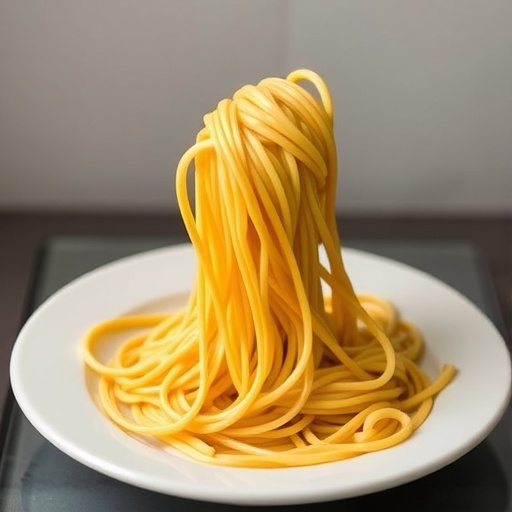Boiling spaghetti might seem like an uncomplicated task, but recent research has uncovered the intricate science behind why traditional wheat-based pasta maintains its integrity while gluten-free alternatives tend to disintegrate when exposed to heat. Traditional pasta’s secret weapon lies in gluten, a protein that plays a pivotal role in preserving the structure of spaghetti during the cooking process. This fascinating study was conducted by a team of researchers who employed advanced techniques to scrutinize the microscopic architecture of both regular and gluten-free spaghetti.
By utilizing sophisticated methods such as small-angle neutron scattering and X-ray analysis, the researchers were able to explore the internal makeup of pasta at a molecular level, revealing the underlying interactions that occur during the cooking process. Gluten’s remarkable properties demonstrate its capability to form a matrix that encapsulates starch molecules, acting as a protective barrier during the boiling phase. This matrix not only keeps the pasta intact but also enhances its texture, ensuring a pleasant eating experience.
Andrea Scotti, a senior lecturer in physical chemistry at Lund University, explains that the gluten present in conventional spaghetti serves as a safety net. It safeguards the structural integrity of pasta, enabling it to withstand various cooking conditions. In stark contrast, gluten-free pasta, typically composed of alternative flours that lack this protein, relies on synthetic additives to provide a similar texture. However, these artificial matrices are sensitive to cooking conditions; if they are not precisely regulated, gluten-free pasta is more likely to fall apart.
Interestingly, the research also highlights the role of salt in the boiling water. The findings suggest that the level of salt not only contributes to flavor but also significantly influences the pasta’s structural integrity. Regular pasta exhibits superior resistance to imperfect cooking conditions, such as overcooking or excessive salinity. This demonstrates that the gastronomic principle of salting the pasta water is not merely a culinary preference but a scientifically informed choice that affects the resultant microstructure of the final dish.
Moreover, the implications of this research expand beyond the kitchen. With gluten-free diets gaining popularity due to health concerns and lifestyle choices, understanding the structural dynamics of gluten-free pasta is essential for product developers. The study sets the stage for potential advancements in creating gluten-free products that can better mimic the cooking resilience of their gluten-containing counterparts. The researchers aim to refine these insights further by investigating additional pasta varieties and exploring the effects of various manufacturing processes.
The implications of gluten and salt go beyond cooking; they extend into the realm of nutritional science. As the research team plans to delve deeper into how pasta behaves under digestion, there is a growing interest in understanding how these factors interact with our body biochemically. The ongoing research seeks to reveal not just how gluten-free pasta can be engineered for optimal cooking but also how it affects our health post-consumption, shedding light on the glycaemic index and other nutritional aspects.
The study’s collaborative nature enhances its robustness, with significant contributions from Judith Houston and institutions such as the European Spallation Source and the Diamond Light Source. Their collective expanse of expertise provides a multidisciplinary approach to understanding food structures, laying the groundwork for innovations that can cater to modern dietary needs.
In a world where dietary restrictions are increasingly common, the quest for more durable, nutritious, and satisfying gluten-free alternatives is essential. This research provides a pathway for developers to engineer pasta that meets not just the culinary expectations of consumers but also adheres to their dietary requirements. By leveraging the findings of this research, there is an opportunity to combine functionality with taste, ensuring that no one has to sacrifice quality for dietary compliance.
In conclusion, the intricate balance of gluten and salt reveals much about the culinary art of pasta cooking and the science underlying it. The discoveries outlined in this study not only pave the way for improved gluten-free pasta but also enrich our understanding of how cooking techniques can significantly affect food structure and nutrition. The implications are as rich as the pasta itself, heralding a new era of research into both traditional and alternative pasta products.
As consumers become more educated about their food choices, studies like these underscore the importance of scientific inquiry in the culinary arts. The balance of flavor, texture, and nutritional value is critical to consumer satisfaction, and ongoing research will undoubtedly play a vital role in determining how pastas of all kinds can be optimized for the modern table.
This research not only provides critical data for food scientists and manufacturers but also enriches our collective culinary knowledge, bridging the gap between science and gastronomy in ways previously unimagined.
Subject of Research: The role of gluten and salt in maintaining the structural integrity of spaghetti during cooking.
Article Title: A small-angle scattering structural characterization of regular versus gluten-free spaghetti
News Publication Date: [Not provided in the original text]
Web References: [Not provided in the original text]
References: [Not provided in the original text]
Image Credits: [Not provided in the original text]
Keywords
Gluten, spaghetti, gluten-free, cooking science, food structure, starch, pasta, culinary science, nutritional science, advanced techniques, consumer preferences.




